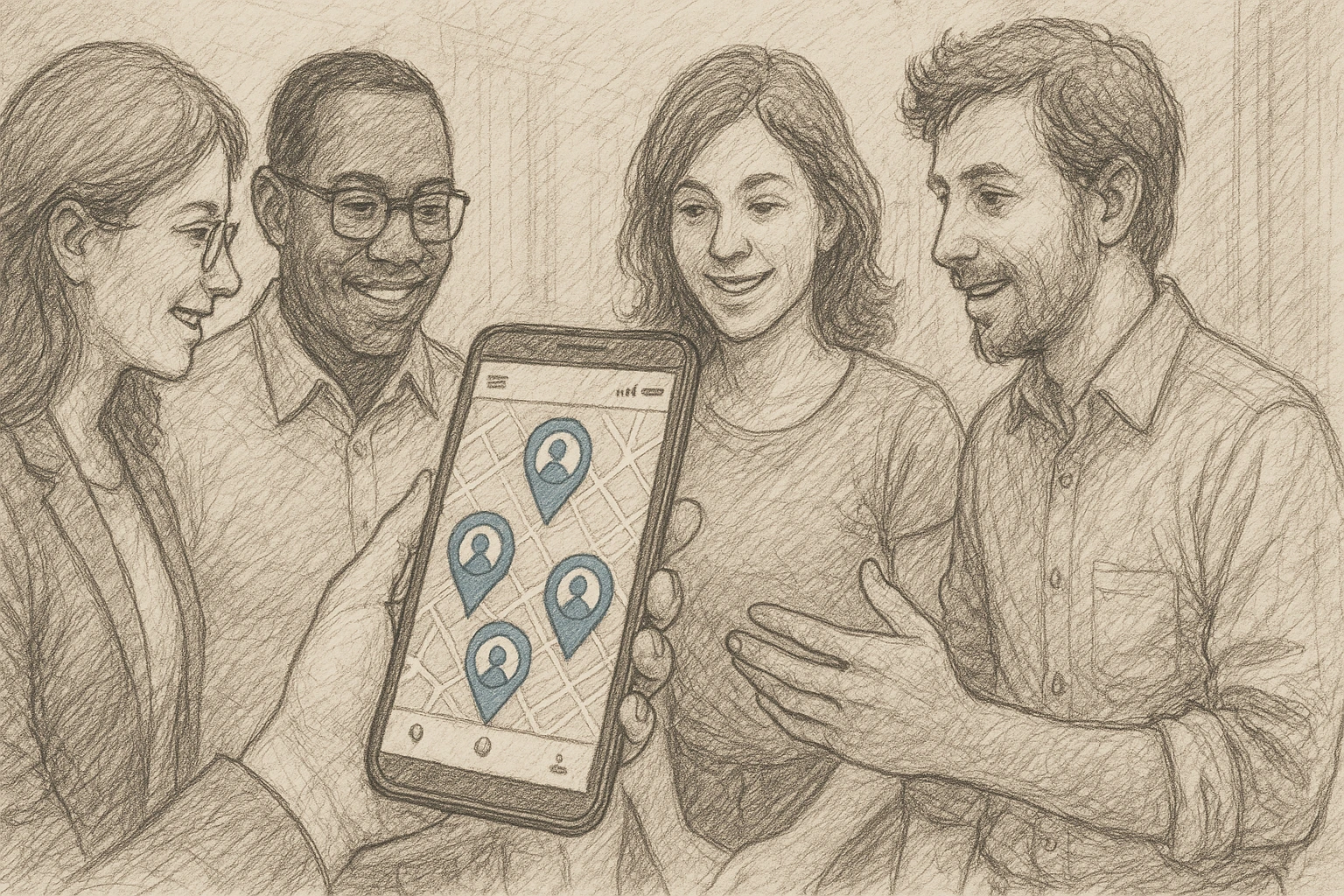Bringing people together for a shared experience—whether it’s a corporate retreat, a weekend hiking trip, a family reunion, or a volunteer mission—should be enjoyable. But anyone who’s attempted to plan such activities knows that behind the smiles and photo ops lies a logistical puzzle: coordinating multiple schedules, keeping everyone informed and finding out how accurate is location sharing on iPhone to check everyone’s route, and ensuring things go smoothly in real time.
In the past, this meant juggling email chains, group chats, phone calls, shared spreadsheets, and a lot of back-and-forth. But in today’s fast-paced world, these old-school methods fall short. Missed messages, forgotten tasks, and last-minute changes turn what should be a fun, purposeful event into a frustrating exercise in miscommunication.
That’s where modern technology steps in—not just to simplify the planning process but to completely transform how groups coordinate, communicate, and stay connected.

Why Technology Is a Game-Changer for Group Planning
When it comes to organizing group activities, tech doesn’t just save time—it reduces stress, enhances participation, and improves safety. The biggest pain points—schedule conflicts, unclear responsibilities, and communication gaps—can all be addressed using tools specifically built to solve them.
Let’s break down the core advantages:
1. Centralized Communication
Instead of managing multiple message threads across different platforms, tools like Slack or Microsoft Teams consolidate conversations into organized, searchable channels. You can create dedicated threads for logistics, accommodation, activities, or general updates—keeping everyone in sync without overwhelming them.
2. Real-Time Collaboration
Need to finalize a trip itinerary or divide volunteer responsibilities? Project management tools like Trello, Asana, and Teamhood offer real-time boards and lists that everyone in the group can view and edit simultaneously. This eliminates the need for constant email updates and ensures no detail is overlooked.
3. Automated Scheduling & Reminders
Forget chasing people for confirmations or updates. With calendar integrations and notification features, modern tools can send automatic reminders, alert team members about task deadlines, and prompt follow-ups—keeping everyone on the same page effortlessly.
4. Enhanced Safety with Location Tracking
This is particularly crucial for off-site or outdoor activities. With apps like Number Tracker, organizers can discreetly monitor participants’ locations via their smartphones. It’s not about surveillance—it’s about ensuring safety, preventing delays, and enabling faster response in case of emergencies.
Real-Life Scenario: Planning a Volunteer Beach Cleanup
Consider a group organizing a beach cleanup event. Here’s how tech simplifies the process:
- Trello is used to create a project board with cards for equipment, location permits, team assignments, and media coverage.
- Slack helps volunteers stay in touch in dedicated channels—logistics, transportation, and weather updates.
- Google Forms collects RSVPs, shirt sizes, and emergency contacts.
- On the day of the event, Number Tracker helps the coordinators ensure all groups have arrived safely and alerts them if someone goes missing or strays too far from the designated area.
With this setup, the organizers aren’t scrambling with paperwork and calls—they’re leading an impactful, well-managed event supported by real-time technology.
Why Old-School Methods No Longer Work
Let’s be honest: traditional organizing methods weren’t designed for today’s mobile, multitasking world. Here’s how they typically fall short:
| Challenge | Old-School Method | Tech-Powered Solution |
| Juggling schedules | Endless emails & texts | Shared calendars with real-time availability |
| Tracking responsibilities | Handwritten lists, Excel docs | Trello, Asana boards with deadlines |
| Safety during offsite events | Group calls, manual check-ins | GPS-based apps like Number Tracker |
| Gathering feedback | Informal chats | Google Forms, SurveyMonkey surveys |
By switching to digital tools, organizers save countless hours while boosting participation and confidence in the group’s success.
Once you understand the power of technology in organizing group activities, the next step is choosing the right tools for your needs. From managing tasks and streamlining communication to ensuring safety and gathering feedback, today’s tech ecosystem offers a diverse suite of solutions that can be tailored to any type of group event.
Below is a curated list of essential tools, categorized by function, with actionable tips on how to use each one effectively.
🔧 Project & Task Management Tools
Keeping track of who’s doing what—and by when—is one of the biggest challenges in group organization. These tools allow you to visualize progress, assign roles, and create clarity from chaos.
Trello
- What it does: Trello uses visual boards, lists, and cards to map out tasks and deadlines.
- How to use it: Create a board for your group event, with columns such as “To Do,” “In Progress,” and “Done.” Assign cards to specific members, attach checklists, and set due dates.
- Pro tip: Integrate Trello with Google Calendar to sync deadlines and reminders automatically.
Asana
- What it does: Asana is ideal for more complex or recurring events. It breaks tasks into subtasks, supports timeline views, and enables real-time progress tracking.
- How to use it: Use templates for event planning to save time. Create sections for logistics, communication, budget, and post-event wrap-up.
- Pro tip: Use the “Milestone” feature to mark key dates like registration deadlines or travel days.
Teamhood
- What it does: Teamhood offers customizable workflows, including time tracking and workload balancing.
- How to use it: If your event includes multiple teams or shifts (e.g., volunteers for different time slots), Teamhood is ideal. Create folders for each team and assign time blocks.
- Pro tip: Enable real-time reminders so no one forgets their responsibilities.
💬 Communication & Feedback Platforms
Clear communication can make or break a group activity. Whether you’re planning logistics or adjusting to changes on the fly, these tools ensure everyone’s voice is heard.
Slack
- What it does: Slack organizes conversations into channels by topic, allowing for instant and asynchronous communication.
- How to use it: Set up separate channels for different aspects of the event—such as #logistics, #accommodation, #transport, and #general. Use @mentions to get specific people’s attention.
- Pro tip: Pin key messages and upload documents for easy reference.
Zoom & Google Meet
- What they do: These platforms are perfect for remote coordination or hybrid teams. Both support screen sharing, breakout rooms, and recordings.
- How to use them: Schedule check-in calls before the event, use breakout rooms for small group planning, and record sessions for those who can’t attend live.
- Pro tip: Google Meet allows you to assign breakout groups in advance—ideal for pre-set planning teams.
Google Forms & SurveyMonkey
- What they do: These survey tools help you gather input, RSVPs, or preferences from your group.
- How to use them: Send out a form in advance asking about dietary restrictions, availability, and equipment needs. Post-event, use the same tool to collect feedback.
- Pro tip: Add conditional logic to your forms (e.g., if someone says they need transportation, a new section appears to collect pick-up details).
📍 Location Tracking & Safety Solutions
Especially useful for outdoor adventures, excursions, or events involving minors, location tracking tech ensures peace of mind.

Number Tracker App
- What it does: Allows users to track a phone’s real-time location and view historical location data using just a phone number.
- How to use it: Ask participants to install the app or agree to location sharing during the event. Use the dashboard to monitor group distribution and identify anyone running late or off-route.
- Use cases:
- A hiking group is split into two trails—organizers use the app to track both teams’ locations.
- A team-building treasure hunt uses the app to ensure no one strays from the designated area.
- Parents supervising a youth trip can check on the kids’ safety discreetly.
- Pro tip: The app’s interface allows for quick viewing of multiple phones—ideal for large groups.
Now that you’ve discovered the top tools for organizing group activities, the final step is mastering how to use them efficiently. Even the best apps and platforms can fall short without the right strategy. In this section, we’ll walk through expert-backed best practices that make your planning process smoother, your communication more impactful, and your events more successful—from beginning to end.
✅ 1. Centralize All Information in One Digital Hub
Jumping between different apps or message threads quickly leads to lost information and duplicated work. The first rule of modern group coordination is centralization.
How to do it:
- Choose one project management tool (like Asana or Trello) and make it your group’s single source of truth.
- Include links to documents, forms, maps, contacts, and meeting notes.
- Update the board regularly and tag relevant members when changes occur.
Why it works:
With everyone referencing the same digital board, misunderstandings are minimized and accountability increases.
💬 2. Use Real-Time Communication for Speed and Clarity
Even the best-laid plans need adjustments. That’s why real-time messaging tools like Slack are indispensable. They help groups react quickly and coordinate last-minute changes without flooding inboxes.
Best practices:
- Create themed channels (e.g., #transport, #schedule, #weather).
- Use emojis and reactions to quickly acknowledge messages.
- Turn on notifications for important mentions or channel updates.
Bonus tip:
Encourage a quick daily check-in or status update from all team members to catch potential delays before they snowball.
🔔 3. Automate Updates and Reminders
Manual follow-ups are not only time-consuming—they’re prone to being forgotten. Most task and calendar apps now allow automation.
What you can automate:
- Task reminders before due dates (Trello and Asana both support this).
- Meeting invites and location details via Google Calendar.
- RSVP follow-ups through automated emails in Google Forms or SurveyMonkey.
Use it to:
- Remind volunteers of arrival times.
- Send updates about changes in meeting points or weather.
- Nudge team members to confirm their participation.
📍 4. Prioritize Safety with Location Sharing
Whether you’re coordinating a remote offsite, a youth trip, or a hike, knowing where everyone is at any moment can be vital.
Why use Number Tracker App:
- It tracks phones by number—no need for complex installations.
- Organizers can view both real-time and historical movement.
- Helps locate late arrivals or lost participants discreetly.
Safety strategy:
- Get participants’ consent before enabling tracking.
- Use tracking only for duration of the activity.
- Share your own location as a sign of transparency.
Outcome:
Less stress for the organizer, peace of mind for participants, and fewer delays or missing persons.
📝 5. Gather Feedback—and Actually Use It
No event is complete without reflection. Post-activity feedback gives you insight into what worked, what didn’t, and how to improve next time.
Tips for meaningful feedback:
- Send a survey using Google Forms or SurveyMonkey right after the event ends.
- Ask both quantitative questions (rate from 1–5) and qualitative ones (What could we improve?).
- Keep it short—no more than 5–7 questions to boost response rates.
Don’t forget to:
- Thank participants for their input.
- Share a summary of results with your group.
- Implement key takeaways in your next event.
By mastering these tools and workflows, you’ll be better equipped to bring people together—whether you’re leading a team-building event, hosting a community cleanup, or organizing a getaway with friends.
So go ahead—make your next group activity not just easier, but smarter, safer, and more rewarding than ever before.
